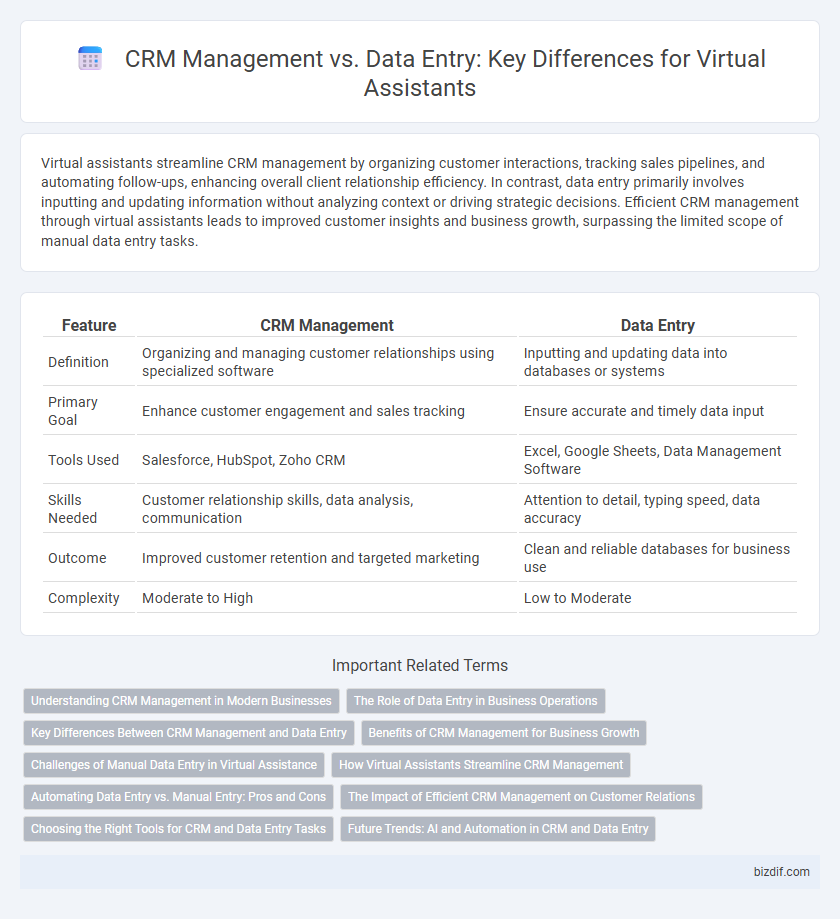Virtual assistants streamline CRM management by organizing customer interactions, tracking sales pipelines, and automating follow-ups, enhancing overall client relationship efficiency. In contrast, data entry primarily involves inputting and updating information without analyzing context or driving strategic decisions. Efficient CRM management through virtual assistants leads to improved customer insights and business growth, surpassing the limited scope of manual data entry tasks.
Table of Comparison
| Feature | CRM Management | Data Entry |
|---|---|---|
| Definition | Organizing and managing customer relationships using specialized software | Inputting and updating data into databases or systems |
| Primary Goal | Enhance customer engagement and sales tracking | Ensure accurate and timely data input |
| Tools Used | Salesforce, HubSpot, Zoho CRM | Excel, Google Sheets, Data Management Software |
| Skills Needed | Customer relationship skills, data analysis, communication | Attention to detail, typing speed, data accuracy |
| Outcome | Improved customer retention and targeted marketing | Clean and reliable databases for business use |
| Complexity | Moderate to High | Low to Moderate |
Understanding CRM Management in Modern Businesses
CRM management streamlines customer interactions by organizing data into actionable insights, enhancing client relationships and sales strategies. Unlike basic data entry, which involves inputting information, CRM management requires analyzing customer behavior patterns and automating marketing workflows. Modern businesses leverage CRM platforms like Salesforce and HubSpot to optimize customer retention and drive revenue growth.
The Role of Data Entry in Business Operations
Data entry is fundamental to accurate CRM management, ensuring that customer information is consistently updated and organized for effective decision-making. Efficient data entry minimizes errors and enhances data integrity, which directly impacts sales tracking, customer support, and marketing strategies. Reliable data input streamlines business operations by enabling seamless access to real-time customer insights within CRM platforms.
Key Differences Between CRM Management and Data Entry
CRM management involves strategically organizing customer interactions, tracking sales pipelines, and analyzing customer data to enhance business relationships and drive growth. Data entry primarily focuses on accurately inputting, updating, and maintaining information within databases or systems without direct influence on strategic decision-making. The key differences lie in CRM management's emphasis on leveraging data for customer relationship optimization versus data entry's role in ensuring data accuracy and completeness.
Benefits of CRM Management for Business Growth
CRM management streamlines customer interactions by centralizing data, enabling personalized communication and targeted marketing campaigns that boost customer retention. Automated CRM tools reduce manual data entry errors and free up valuable time for sales teams to focus on relationship building and closing deals. Enhanced data analytics within CRM systems provide actionable insights that drive strategic decision-making and accelerate business growth.
Challenges of Manual Data Entry in Virtual Assistance
Manual data entry in virtual assistance often leads to increased errors, inconsistencies, and time inefficiencies, negatively impacting CRM management. The complexity of updating customer information manually can result in duplicated records and lost data, reducing the overall accuracy and reliability of the CRM system. Implementing automated solutions for data capture and synchronization is essential to overcome these challenges and enhance virtual assistant productivity.
How Virtual Assistants Streamline CRM Management
Virtual assistants enhance CRM management by automating data entry, ensuring accurate and up-to-date customer information without manual input errors. They integrate with CRM platforms to track customer interactions, schedule follow-ups, and generate detailed reports, improving workflow efficiency. This streamlining reduces administrative burdens, allowing businesses to focus on personalized customer engagement and strategic growth.
Automating Data Entry vs. Manual Entry: Pros and Cons
Automating data entry in CRM management significantly reduces errors and saves time by seamlessly integrating information from multiple sources, enhancing overall data accuracy. Manual entry, while allowing for personalized data validation and contextual adjustments, often leads to slower processing and increased risk of human error. Leveraging automation tools like AI-powered data capture and RPA boosts efficiency, but organizations must balance initial setup costs and potential integration challenges against the long-term benefits of streamlined CRM workflows.
The Impact of Efficient CRM Management on Customer Relations
Efficient CRM management enhances customer relations by providing accurate, real-time data that streamlines communication and personalizes interactions. Unlike basic data entry, CRM systems organize customer information dynamically, enabling virtual assistants to track purchase history, preferences, and support issues effectively. This leads to improved customer satisfaction, loyalty, and targeted marketing strategies, maximizing business growth and operational efficiency.
Choosing the Right Tools for CRM and Data Entry Tasks
Effective CRM management relies on integrated platforms like Salesforce or HubSpot that automate customer interactions and provide real-time analytics, enhancing decision-making and client retention. In contrast, data entry tools such as Zoho Forms or Google Sheets prioritize accuracy and speed in handling repetitive information input tasks but lack advanced CRM functionalities. Selecting the right tool depends on business needs: CRM software streamlines relationship management, while specialized data entry applications ensure efficient handling of large datasets.
Future Trends: AI and Automation in CRM and Data Entry
AI-driven CRM systems enhance customer relationship management by automating data entry tasks, increasing accuracy, and enabling predictive analytics for personalized marketing strategies. Future trends indicate growing integration of machine learning algorithms to streamline workflow, optimize customer interactions, and reduce manual workloads in data entry processes. Automation tools powered by natural language processing further improve real-time data capture and analytics, transforming CRM management into a dynamic, efficient ecosystem.
CRM management vs Data entry Infographic

 bizdif.com
bizdif.com